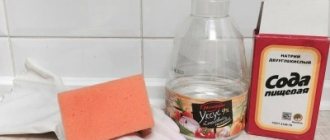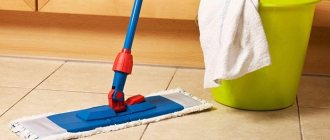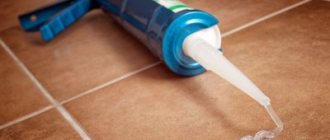Of all the household problems that home and apartment owners have to fix, clogged drains are the most common; the kitchen sink and bathtub are equally likely to become clogged. To effectively solve the problem of what to do when the water in the bathroom does not drain, you should know the causes of blockages in order to prevent them, folk, traditional and modern high-tech cleaning methods.
As a rule, any owner can deal with sewer blockage on his own without calling a plumber thanks to mechanical devices and modern chemicals. Unlike a clogged sewer riser, which causes emergency situations with the inability of all residents along the riser to use the sewer system, the lack of drainage from the bathroom is not so catastrophic and can be eliminated gradually over a certain period of time.
Connecting the bath to the sewer
Using a plunger against blockages
At home, a plunger will help you deal with a clogged blockage in the bathroom. To ensure that there is no air passage, it is necessary to close the upper hole for draining water with a stopper or rag. Vaseline or any greasy cream will help ensure a tighter fit of the plunger to the toilet rim. Then you need to place a plunger on the drain hole and begin to intensively and sharply expel the contaminants to get rid of them.
If using the previous method did not bring any results, then you can proceed as follows. For more effective protection against blockages, it is necessary to fill the bathtub exactly one-third full with water. Using a plunger, pump it into the pipeline and pull it out. The movements should be sharp. It is necessary to continue this procedure until the drain hole in the pipe is completely cleared of contaminants.
Incorrect pipe slope
If the water in the bathroom does not drain well, but there is no blockage, then the cause of the problem most likely lies in a violation of the plumbing technology. Perhaps the pipe slope is insufficient, so that the draining water does not reach the socket. This is determined visually. To increase the slope of the pipe, you need to lower or raise the bath.
The standard maximum slope is 15%. The optimal value is 30-50 mm per meter of pipe. With slopes less than 15 or more than 60 mm, the likelihood of blockages significantly increases. In addition, it is not recommended to install corner elements at 90 degrees when laying the system. If necessary, it is better to install two turns at 45 degrees.
Mechanical cleaning using a cable
What to do in a situation where boiling water combined with a plunger cannot clear blockages in the sewer? In this case, the surest way would be a cable. Care should be taken, as this device can easily damage plastic pipes and cause them to leak.
To make a cable yourself, you will need a metal flexible wire. Then one end of the cable must be bent to form a small hook. It will be convenient for them to catch debris stuck in the drain hole and pull it out. As for the second end, a piece of fabric should be tied to it, making a handle.
You need to carefully insert the cable inside the drain pipe and try to push through the accumulated dirt. For better cleaning, you can rotate the device clockwise. Then you need to pull out the cable with the remaining debris.
To completely remove the clog, you need to flush the drain with a strong stream of boiling water from the shower or tap. This method is one of the most effective today. This is what most plumbers use.
When to call a plumber
You should contact a specialist if none of the home methods have worked or the problem progresses. Also, a visit to a specialist is required if there are frequent repeated blockages - several times a month.
Call a plumber even when, after carrying out some independent manipulations, the situation only partially improves.
How much does it cost to call a specialist?
It is difficult to answer this question unequivocally. Most often, contacts of good plumbers are passed from hand to hand. Such masters work well and charge an adequate price for the manipulations performed - on average 3,000 rubles .
If you contact special organizations that have their own websites, then it will not be difficult to find out the price - it is necessarily posted on the official website of the company providing plumbing services.
Some apartment owners prefer to contact specialists who work on their property in housing and communal services. They assume that in this case the work will cost less. But in fact, even attached plumbers work at average prices.
Soda for minor blockages
Baking soda combined with baking soda will help you deal with a small clog in the bathtub without a plunger. For this:
- pour 125 mg of each product into the drain hole;
- pour soda and salt with 3 cups of boiling water;
- do not use the bathroom for 7 hours;
- After this time, the drain should be rinsed with hot water.
One of the most popular ways to remove debris from a drain hole with improvised means is to use soda and vinegar. These components react with each other and effectively remove the blockage. For this procedure you will need acetic acid 70% (200 ml) and 3 tbsp. l. soda
Be careful when working with vinegar as it is very easy to get a chemical burn. Soda is poured into the drain and filled with acetic acid. Then you should wait 40-50 minutes and carefully clean the drain with boiling water until the foam from the soda and vinegar disappears completely. It should be remembered that this method will only help destroy organic waste. If the bathtub is clogged and needs to be cleaned of inorganic contaminants, then it is best to use a cable, a plunger, or store-bought products.
Insufficient section size
Is the water draining poorly in the bathroom? If the “wrong” pipes are installed, you will have to change the entire system so that you no longer face the problem of constant blockages. Previously, designers were generally limited to three sections: 150 mm cast iron pipes were rarely used inside buildings, risers were assembled from 100 mm ones, and the rest were assembled from 50 mm ones. Today, the range of products has expanded significantly. In most cases, pipe diameter and configuration are selected based on recommendations and regulatory requirements.
For internal networks, any available diameter of cast iron (50, 100, 150 mm) or plastic (16-160 mm) sewer pipe can be used. A cross-section of 32 mm or more is suitable for a bathroom sink where fats do not drain. For kitchen sinks, bath and shower drains, washing machines and dishwashers, a pipe of at least 40 mm in diameter is required. For a combined bathtub and shower drain, it is better to choose 50 mm, more than three appliances without a toilet are connected to a horizontal “bed” 60 mm, more than five appliances - 75 mm, toilet and vertical risers - 100-110 mm.
Other effective ways
If the bathtub is not too clogged, you can use lemon. To do this, squeeze the juice from three medium-sized citrus fruits into the drain and wait 40-60 minutes. To get more juice, you can first keep the lemons in boiling water. After this, you need to flush the drain with very hot water. Thanks to this method, not only the debris in the bath is eliminated, but also the unpleasant odor.
Video - proven cleaning methods:
You can remove dirt in the drain hole with a vacuum cleaner equipped with a backflow function. The action of this method is based on the use of strong air pressure. Experts do not recommend using this method, as water may get into the vacuum cleaner. If you nevertheless decide to remove the blockage in the bathtub using this method, you should wipe the rim of the drain hole dry. Then attach the vacuum cleaner tube, previously wrapped with a rag, to the drain and turn on the reverse blowing.
Cleaning the drain and siphon
Small debris that turns into rotting sludge or mold that emits a foul odor is usually collected in the drain and siphon. To clean these areas, you need to remove the siphon and unscrew the mesh that holds the tube. The entire contents of the siphon must be thrown into the toilet and flushed several times. Bowls, all internal tubes, gaskets, mesh and siphon should be washed thoroughly under running water with a degreaser. It's okay if you don't have a special detergent for your plumbing. Regular dishwashing detergent effectively dissolves fats and removes dirt.
What to do if traditional methods do not help?
Chemical products that are sold in hardware stores will help you quickly and effectively get rid of clogged debris. They are designed to remove organic contaminants (hair, pet dander, food debris, etc.). They resort to their help when it is impossible to cope with a clogged bathroom using folk remedies.
In what form is it best to purchase household chemicals? Despite the fact that such drugs are sold in the form of foam, powders, gels and granules, they all have an almost identical composition.
Cleaning clogged sewer pipes in the bathroom with KROT cleaning agent - video:
The following tips will help you clean a heavily dirty pipe:
- it is very important to read the instructions before using chemical clog removers;
- experts recommend choosing solvents in order to remove blockages based on the nature of the pipe (for example, plastic or cast iron);
- Both powder and liquid preparations have the same effectiveness, so it does not matter which type of preparation will be used to clear a severe blockage in the bathroom;
- Clogging solvents in liquid form are immediately poured into the drain, and granules or powders are poured out, and then boiling water is poured into them;
- After the drug has run out of time allotted to it by the instructions, you need to thoroughly rinse the drain with a stream of hot water.
It is also very important to use rubber protective gloves when working with such chemicals.
How to fix
Inside the bathroom
We first determine the location of the blockage. If water does not drain from the sink, but does not linger in the bathroom, the sink siphon is clogged. When there is a bad odor coming from your bathtub drain and strands hanging off the crossbar, the U-flap or corrugation is likely clogged.
If the water drains at first and then stands, it may be a riser. With a combined kitchen and toilet sewer system, proper functioning of the toilet indicates a clogged wiring inside the room.
There are three cleaning methods:
- hydraulic;
- mechanical;
- chemical.
Hydraulic “emergency” is carried out with a plunger; at the initial stage it is usually possible to break through the plug. The plunger allows you to clean the system by alternately creating a vacuum - excess pressure by a compressible rubber valve. The liquid, together with the dirt, rushes under the kvach by inertia. Hair caught on the crosspiece is removed with a crochet hook.
Close the overflow hole tightly with your palm (or a wet rag) for efficient operation of the kvacha. To prevent the rubber valve from sucking in air, immerse it halfway in water.
Plungers for sinks and toilets are sold; the latter have a tapering nozzle. Plumbers have powerful piston ones in their arsenal, however, this is not a panacea, since the joints of the plastic wiring cannot withstand excess pressure. Specialists use high-pressure units for hydrodynamic sewer cleaning:
Mechanical cleaning is combined with using a plunger. They use wire hooks, polymer brushes, and devices for winding threads. As a rule, a steel cable is used during partial disassembly, otherwise it is easy to break through the corrugation. The cargo cable and steel wire (“steel wire”) are inferior to the plumbing cable, wound in the form of a flexible shaft with a cross-section of 10–16 mm.
Adviсe:
Accessories:
The equipment listed above helps to temporarily restore patency. The issue can be radically resolved by dismantling the clogged unit. To clean the flat siphon:
- Loosen the union nut connecting the flat elbow to the neck fitting.
- Unscrew the nut connecting the adapter to the outlet or corrugated hose connected to the sewer.
- Remove the elbow along with the adapter (it is acceptable to leave the adapter).
Removing the flat elbow
- Disassemble the assembly by unscrewing the coupling nuts, clean and rinse.
- Check the permeability of the outlet and the area behind it with a wire. The folds of the corrugation trap dirt, so take it out and rinse the sleeve.
- Replace stretched conical seals. Reassemble in reverse order.
Assembling and disassembling the siphon:
Leaking joints are untwisted, dried, coated with silicone sealant, assembled, and the composition is waited for complete hardening according to the instructions on the tube.
The chemical method is more of a preventative measure. Factory-made products are effective against grease, but are powerless to dissolve scale; they will not overcome a ball of hair; the restoration of patency will be temporary.
Be sure to wear protective gloves! Follow the instructions on the bottle label regarding the dosage of the drug, exposure time, and safety precautions.
Do not rely on craftsmen’s recipes, especially those containing acids: excessive concentrations of solutions will damage gaskets, damage the coating of plumbing fixtures, and pose a health risk.
Notes on the device design
Bottle and tubular U-shaped models are designed for sinks; the former are more convenient to maintain. Bathtubs are often equipped with compact U-shaped flat ones. For cheap corrugated siphons, the shutter is installed by bending an accordion accordingly; the design is small-sized, but unreliable. A rigid connection with wiring is preferable to a flexible corrugated hose, but requires precise installation.
Pipe U-shaped.
Bottle
The bottle model does not require complete disassembly; just unscrew the settling tank. Leave a gap between the end of the vertical pipe and the bottom of the tank, otherwise deposits will quickly fill the gap. The distance is adjusted by moving the body along the pipe (for adjustable structures), fixing the position with nuts.
Don't forget to place a basin or bucket under the sink before starting work.
Unscrew the bottom.
Disconnect the sleeve.
We remove the body.
We wash it and put it back.
Sewer riser
In five-story Khrushchev buildings, inspection hatches are provided on the first and top floors; tall buildings were equipped with inspection hatches every three floors. Local cleanouts were also installed - outlets closed with plugs.
The risers of the current plastic network are equipped with revision tees with threaded covers. Similar smaller devices are installed near problem areas: walled up, hidden, sharp bends.
Briefly about the revisions:
If there is no hatch, it is advisable to disconnect the toilet corrugation to gain access to the riser tee. If there is a hard connection, you will have to remove the toilet or clean it through it.
Connecting the toilet using rigid bends.
Clean with a special cable with a handle. The tip can be equipped with hooks that hold fibers, strands, bags, and rags when pulling. It happens that they attach a pointed blank (for example, the peak of a jackhammer), break through the blockage, periodically lifting it and letting it fall freely, it is convenient to operate from the attic:
From the apartment proceed as follows:
- Remove the threaded inspection cover (flanged for cast iron).
- Lower the cable until it stops against the obstacle.
- Holding the whip with your hand, simultaneously rotate the handle.
- They impart a reciprocating motion to the wire to break through the barrier. Periodically remove and remove any trapped debris.
There is a danger of pushing the congestion lower. Then you will have to ask the residents of the lower apartment to open the audit, pushing the blockage towards them and removing the contents by hand. To prevent it from falling further, first plug the inner hole with a rag tied from the outside. Carefully monitor the movement of the spiral; it happens that repairmen pierce the plastic or run the wire towards the neighbors.
They produce mechanized cables with a set of attachments:
The worst option is a cast iron riser laid inside concrete panels. You can only get to it through repair hatches or from the attic. Wet walls of the entrance between floors indicate poor permeability of coupling joints: sewage stagnates and leaks through loosely caulked joints. For repairs, it is necessary to dismantle the brickwork covering the technical openings in the entrance.
An example from experience: “metalworkers” pulled out a drain pipe in the attic, dumping slag into the riser, and the cast-iron sewer system became tightly clogged. It was not possible to break through the jam with a cable or a load. The plumbers dismantled the masonry of the opening in the entrance, cut out a pipe segment with a grinder, and removed a bucket of slag. The hole was closed with a rolled sheet, welded with an electrode using cast iron.
External reasons
The sewage system in the basement or manhole usually becomes clogged due to the fault of careless residents who wash away unusable preserves, rags, bags, and construction waste. The latter can indirectly point to the culprit of the emergency.
The approximate location of the blockage is sometimes visible from the joints leaking under high pressure. Don’t try to do something yourself, call the management company. A clogged well is filled with sewage flowing out, and it’s time to call an emergency.
Measures to prevent contamination in the bath
In order to prevent contamination in the sink or bathtub drain, it is necessary to devote time to preventative procedures. Their implementation will not take much time, and the tools that need to be used can be found in every home.
To prevent water pipes from becoming contaminated with waste, and to prevent a situation where water does not drain well, it is necessary to cover the drain holes with special nets for protection. This device will help minimize the entry of food particles and other organic waste into the drain.
- Accumulated debris should be dissolved at least once a month. This applies even to situations where the blockages are not yet too large and water flows freely into the sewer. This procedure will prevent the formation of traffic jams. It can be carried out using products sold in the store (Mole, Tiret Turbo, etc.).
- Regular laundry detergent can replace such chemicals. To prevent blockages, it is necessary to close the drain holes of the bathtub and sink every 4-5 months. After this, pour a handful of powder and add very hot water. After 5 minutes, the plugs must be removed. This method will also help get rid of the unpleasant odor from the drain.
- To prevent blockages from appearing for a long time, you can pour boiling water from a kettle over the drain hole. This procedure should be carried out within 2–3 minutes.
It is also very important to remove any hair caught in the drain after each shower.
Causes of the problem
If the water does not drain well from the bathtub, then at first glance it is difficult to determine the cause of the blockage. The problem may be due to one of several reasons. To fix the problem, you will need to use the right method and the right tools.
If the drain is clogged
The drain hole becomes clogged due to hair, pet hair, grease and soap deposits. These blockages are easy to remove with your own hands, because you don’t need to disassemble the system much.
Failure to comply with pipe slope
In order for the pipeline to function properly, the installation rules must be followed correctly. During installation, the slope of the pipe must be observed. The diameter of the pipe affects the slope value. If the slope is too small, then there is a high probability of blockages, the pipeline will have to be redone, and the help of a professional will be required when dismantling the pipes.
Incorrect diameter selection
As a rule, pipes in houses are made of plastic or metal. The diameter of the pipe affects the throughput of the pipeline. If the cross-section is small, then little water passes through the pipes. In such pipes, blockages form faster. This pipeline parameter may change due to mud deposits on the pipe walls.
Attention! An incorrectly selected diameter for pipes in the system increases the occurrence of plugs by up to sixty percent.
The sewer is clogged
This type of clog is more complex than a clogged drain. The sewer can become clogged due to mechanical stress or fat deposits. Chemical cleaning or cable cleaning will be required. The location of the blockage must be correctly determined; it may be difficult to reach. If the riser is clogged, it is better to call a plumber.
Video
In order to understand the nuances of drain cleaning using mechanical methods, folk and chemical means, watch the presented videos:
About the author:
Found a mistake? Select the text with the mouse and click:
Do you know that:
There are special traps to combat moths. The sticky layer with which they are covered contains female pheromones that attract males. By sticking to the trap, they are eliminated from the reproduction process, which leads to a decrease in the moth population.
What harm can it cause to health?
Usually people believe that the smell from the bathroom in the house brings nothing but discomfort. But this is not so, because household members inhale vapors of ammonia and hydrogen sulfide. There are methane impurities in the air. Inhaling toxic fumes every day, residents suffer from nervousness, they experience anxiety, restlessness, and irritability for no reason.
Mold develops on the walls due to dampness. Fungi enter the human body, causing the person to get sick. He develops pathologies of the respiratory organs and gastrointestinal tract. Staying in the room for a long time will lead to serious poisoning. Prolonged exposure to methane has a negative effect on the autonomic system of residents, which produces a nervous tic in the eye area. And oxygen starvation of brain cells causes weakness, nausea, dizziness, and a drop in blood pressure.
Sealing sewer joints
Often pipes begin to leak at the joints. Work needs to be done to correct the problems. Using fum tape will help eliminate leaks temporarily. Therefore, it is better to use a sealant.
Silicone
One of the best types of sealant will help hold the pipes together firmly. They will last a long time if the joints are lubricated with silicone. The compositions do not shrink and retain their properties even with sudden temperature changes.
Acrylic
Although such sealants have low elasticity, they will last a long time. Their advantage is their ability to repel water. They adhere to joints at any temperature.
Silicone-acrylic
Sealants are used not only at pipe joints. They “treat” cracks, chips, and seal seams in areas of the plumbing system.
Polyurethane
Apply sealant to the damaged area with a spatula. When it dries, the system is started. Polyurethane sealant takes paint well.











